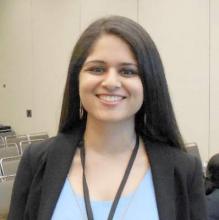BALTIMORE – Children with systemic juvenile idiopathic arthritis have the best odds for responding to initial treatment with a nonsteroidal anti-inflammatory drug if they are no older than 6 years old, have five or fewer involved joints, and have a serum level of C-reactive protein that is at or below 13 mg/dL, based on a review of 57 children with systemic juvenile idiopathic arthritis treated with these drugs at a single U.S. center during 2000-2014.
“We recommend a trial of NSAID [nonsteroidal anti-inflammatory drug] monotherapy for these patients with systemic juvenile idiopathic arthritis [JIA],” Dr. Anjali S. Sura said at the annual meeting of the Pediatric Academic Societies. A reasonable trial of NSAID monotherapy would last 6 weeks; if patients failed to adequately respond at the end of 6 weeks, it would be reasonable to switch to another of the first-line drugs recommended for children starting treatment for JIA, either a glucocorticoid or the biological agent anakinra (Kineret), said Dr. Sura, a pediatrician at the University of Michigan in Ann Arbor.
Initial treatment with a NSAID is preferred, even though it will probably work in only about a quarter of patients, because it generally has the best safety profile among these three options, Dr. Sura said in an interview. “If we can risk-stratify children with systemic JIA for NSAID therapy” using these three criteria, “then NSAID monotherapy may be more effective,” she explained.
The NSAIDs most commonly used to treat systemic JIA are naproxen or indomethacin, at anti-inflammatory dosages, which for naproxen is 15-20 mg/kg per day, and for indomethacin 3-4 mg/kg per day, she said.
But Dr. Sura also cautioned that the analysis she presented focused on a relatively small and selected group of children with systemic JIA who received initial NSAID monotherapy. The series she and her associates reviewed included 99 patients, of whom 57 received NSAID monotherapy; 35 of these patients were 6 years old or younger.
The researchers compared the 15 NSAID responders (26%), defined as patients who had clinically inactive disease, with the 42 nonresponders and identified the three clinical and demographic characteristics that occurred much more often among responders. The ideal candidates for initial NSAID monotherapy should fulfill all three criteria: age, number of affected joints, and serum level of C-reactive protein, Dr. Sura said in her report.
Dr. Sura noted that a panel of the American College of Rheumatology said that NSAIDs, glucocorticoids, and anakinra were equally good options for initial treatment of JIA in their 2013 update of JIA recommendations (Arthritis Rheum. 2013 Oct;65[10]:2499-512). This 2013 update excepted patients with no actively affected joints, whom the panel said should specifically receive an NSAID, and excepted patients with a high global severity score as rated by their physicians, whom the panel said should receive either a glucocorticoid or anakinra but not NSAID monotherapy. The European League Against Rheumatism has not issued recommendations for managing systemic JIA.
Dr. Sura had no disclosures.
On Twitter @mitchelzoler


